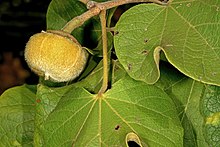| This article needs additional citations for verification. Please help improve this article by adding citations to reliable sources. Unsourced material may be challenged and removed. Find sources: "Thespesia garckeana" – news · newspapers · books · scholar · JSTOR (December 2009) (Learn how and when to remove this message) |
| Thespesia garckeana | |
|---|---|

| |
| Scientific classification | |
| Kingdom: | Plantae |
| Clade: | Tracheophytes |
| Clade: | Angiosperms |
| Clade: | Eudicots |
| Clade: | Rosids |
| Order: | Malvales |
| Family: | Malvaceae |
| Genus: | Thespesia |
| Species: | T. garckeana |
| Binomial name | |
| Thespesia garckeana F.Hoffm.(Exell & Hillc.) | |
Thespesia garckeana /ˌθɛsˈpiːʒə ˌɡɑːrkiˈænə, -ˈɑːnə/ (also known by its synonym Azanza garckeana) is a tree in the family Malvaceae, found throughout the warmer parts of Southern Africa in wooded grasslands, open woodland and thickets. It grows naturally over a range of altitudes from 1,000 to 2,000 m above sea level, from semi-arid areas to areas of higher rainfall. T. garckeana is often found on or near termite mounds in old fields.
Common names: African chewing gum, goron tula, snot apple, tree hibiscus, mutohwe (Shona), nkole (Sri Lanka), uXakuxaku (isiNdebele) and morojwa (Setswana).
Benefits of African chewing gum leaves
- nutrients present in the fruit help cleanse the body system and prevent diseases like cancer, diabetes, high blood pressure, and fertility challenges.
- it serves as an aphrodisiac and aids against liver problems, and mental illness among other diseases.
- it assists in improving bowel movement, eases digestion and improves the body's immune system. Most importantly, it is safe for consumption across all ages.
Uses
- The whole fruit except the seeds is chewed like gum, producing a sweet glutinous slime. The fruit is also used as a syrup and soup.
- The sap wood is yellow and the heart wood is a deep brown. It is easily worked but generally only suitable for small building needs, tool handles, oxen yokes, and domestic items such as spoons.
- The leaves of T. garckeana have many uses including green manure and mulch. The leaves also provide an often used fodder.
Flavour
The flavour is similar in taste to the mango fruit.
See also
References
- "snot apple (Azanza garckeana)". iNaturalist. Retrieved 2024-01-11.
- Mail, The Sunday (2015-09-27). "Matohwe an African delicacy". The Sunday Mail. Retrieved 2024-01-11.
- "Health benefits of African chewing gum". Daily Trust. 2018-06-12. Retrieved 2024-01-11.
- www.diki.pl https://www.diki.pl/slownik-angielskiego?q=green+manure&popupmode=etutor. Retrieved 2024-01-11.
{{cite web}}: Missing or empty|title=(help)
- "Azanza garckeana". Flora of Zimbabwe: Species information. Archived from the original on 2012-02-29. Retrieved 2010-02-08.
- "Azanza garckeana". Ecocrop FAO. Archived from the original on 2011-07-26. Retrieved 2010-02-08.
- Dressler, S.; Schmidt, M. & Zizka, G. (2014). "Azanza garckeana". African plants – a Photo Guide. Frankfurt/Main: Forschungsinstitut Senckenberg.
- The flavour of the fruit is my impression, after tasting it on 2024-09-09. R.A. Von Well
| Taxon identifiers | |
|---|---|
| Thespesia garckeana | |
This Gossypieae article is a stub. You can help Misplaced Pages by expanding it. |
This fruit-related article is a stub. You can help Misplaced Pages by expanding it. |
This fruit tree-related article is a stub. You can help Misplaced Pages by expanding it. |
This Africa-related article is a stub. You can help Misplaced Pages by expanding it. |